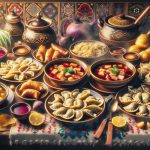
Poland has a rich collection of folklore, fairy tales, and myths that give us a peek into its people’s history and collective mindset. These stories, filled with magical creatures and heroic adventures, are more than just fun tales. They teach important lessons and keep the culture alive.
As we dive into these stories, we might start to think about what they say about human nature and social values. This trip into the world of Polish tales blurs the line between reality and fantasy, sparking interesting conversations and thoughts.
Legendary Creatures of Polish Lore
Poland has a fascinating collection of legendary creatures that reflect its cultural values and historical beliefs. These creatures, many originating from Slavic mythology, aren’t just for entertainment. They also teach important moral and societal lessons. For example, the Wawel Dragon is a classic story of good versus evil, highlighting inner human conflicts. On the other hand, the domovoi represents the early Slavs’ reverence for family and home, showing how they believed in spirits that protected the household.
Polish folklore stands out because it mixes pagan traditions with Christian influences. This blend creates stories that are unique to Poland but also resonate with people everywhere because they speak to universal experiences and values.
Let’s dive into some specifics. The Wawel Dragon, for instance, is not just a scary beast; it’s a symbol of the challenges we face and the courage it takes to overcome them. Stories about the dragon have been told for generations, teaching children about bravery and perseverance. Then there’s the domovoi, a household spirit believed to protect families. This creature shows the importance of home and family in Polish culture and encourages respect for these values.
Polish mythology is full of such characters, each with its own story and lesson. These tales contribute to a rich cultural heritage that offers insights not only into Poland’s past but also into the human condition. They remind us of the power of storytelling in preserving history and teaching future generations.
The Enchanted World of Polish Fairy Tales
Polish fairy tales hold a special place in the world of folklore. They’re known for combining magical elements with lessons about right and wrong. These stories don’t just entertain; they teach. Rooted in Slavic mythology, they touch on universal themes like love, betrayal, and making amends. But they have a unique twist. Unlike stories from other cultures that might focus on a single hero’s journey, Polish tales often emphasize the importance of community and family. This reflects Poland’s history of living and working together closely.
Let’s dive into what makes Polish fairy tales stand out. One key aspect is their connection to Poland itself – the landscape, the history, and the shared experiences of its people play a big role in these stories. For example, you might find tales that are set in specific Polish landscapes, filled with creatures from Slavic mythology. This gives these tales a distinct flavor, different from fairy tales from other parts of the world.
Polish fairy tales often include themes like transformation and trickery, which you might find in other cultures’ stories too. However, it’s how these themes are tied to Polish traditions and values that make them unique. For instance, a story might feature a character who uses cleverness to overcome a challenge, highlighting the value of wit and resourcefulness in Polish culture.
For those interested in exploring these tales further, there are collections that bring together the best of Polish fairy tales. Books such as ‘The Polish Fairy Book’ by Maive Stokes offer a fantastic entry point. These collections not only entertain but also provide insight into the cultural heritage and values of Poland.
Mythical Heroes and Their Quests
Polish folklore is rich with stories of mythical heroes who embark on daring quests. These stories are not just for entertainment; they teach important lessons about bravery, honesty, and the value of community and family ties. Polish tales often mirror those from other cultures, showing common themes of heroism and morality, yet they have their unique flavor, reflecting Polish traditions and values.
For example, the legend of the Wawel Dragon is a classic Polish tale that has been told for generations. It’s about a dragon that terrorized the people of Kraków until a clever shoemaker’s apprentice defeated it. This story teaches the value of intelligence and courage over brute strength. It’s a clear example of how Polish folklore uses exciting narratives to convey deeper messages.
Comparing Polish stories with those from other cultures, we can see how similar human values are celebrated worldwide, yet each culture adds its unique touch. For instance, the concept of the hero’s journey is universal, but the challenges and creatures in Polish folklore are deeply rooted in the country’s geography, history, and beliefs.
These tales offer a window into the Polish collective mindset and societal norms. They celebrate qualities like wisdom, the importance of helping others, and standing up for what’s right. By examining these stories, we can learn not just about Poland’s past, but about the enduring human spirit and the values that connect different cultures.
In a more conversational tone, think of these stories as the old-school version of superhero movies. Just as we admire superheroes for their bravery and moral compass, Polish folklore heroes offer the same kind of inspiration. They remind us that, regardless of where we come from, stories of heroism and virtue resonate with us all. And, just like modern superheroes, these characters and their adventures can be adapted and retold in countless ways, making them timeless.
Dark Entities and Curses Unveiled
Exploring Polish folklore, we uncover stories filled with dark creatures and spells that highlight how fear, ethics, and culture intertwine. These stories aren’t just for entertainment; they’re a way for communities to discuss what they value and what worries them. For example, the wodnik, a dangerous water spirit, and the zmora, a creature that terrorizes people in their sleep, show how these tales embed a caution about the unknown.
Unlike other Slavic traditions, Polish folklore weaves these dark elements with its own history and places, creating a unique cultural narrative. This fusion makes the folklore not just a collection of scary stories but a mirror reflecting universal human concerns about the unseen and mysterious.
Let’s dive deeper into the wodnik and the zmora to understand their roles better. The wodnik, often found in lakes and rivers, serves as a reminder of the respect and caution necessary when dealing with nature. On the other hand, the zmora, attacking people in their sleep, symbolizes the fears that haunt us in our most vulnerable states. These creatures, while frightening, encourage a dialogue about understanding and dealing with our fears.
In discussing these entities, we can draw parallels to similar myths worldwide, emphasizing the common threads that connect different cultures. Through these discussions, we gain a richer understanding of the shared human experience and the ways in which different societies confront the unknown.
In a more practical sense, this exploration of Polish folklore can inspire various cultural products, such as books, movies, or video games, that bring these tales to a modern audience. For those interested in diving deeper, I recommend checking out collections of Polish folk stories or visiting cultural exhibitions that focus on Slavic mythology. These resources can provide a more comprehensive view of the dark but fascinating world of Polish folklore.
Celebrating Poland’s Folk Traditions
Poland’s folk traditions paint a vibrant picture of the country’s cultural heritage and the strong community ties that bind its people together. These celebrations, deeply intertwined with agricultural practices, religious beliefs, and historical milestones, act like a window into Poland’s past and present social fabric. Take, for example, the lively Dożynki harvest festival. It’s a time when the agricultural community comes together to give thanks to nature. This festival stands out with its lively Polish folk music, dance, and distinctive costumes, showcasing a unique aspect of Poland’s cultural identity. It’s similar to thanksgiving celebrations worldwide, yet it carries a distinctly Polish flavor.
On the other hand, Dziady, a solemn tradition that remembers the deceased, offers a different perspective. It’s a reminder of the universal human desire to connect with those we’ve lost, yet it’s deeply rooted in Polish tradition. Through ceremonies and rituals, it highlights how people across various cultures seek to bridge the gap between the physical and spiritual worlds.
Discussing these traditions from an anthropological viewpoint sheds light on their importance. They’re not just about keeping Polish culture alive; they also play a crucial role in building a sense of belonging and strengthening community ties. For instance, participating in Dożynki isn’t just about celebrating the harvest; it’s a communal act that reinforces the connections between individuals and their shared heritage.
In a more relatable sense, these traditions are akin to family reunions or annual community events that many of us look forward to. They offer a chance to reconnect, share stories, and create new memories, all while paying homage to our roots and the journeys of those who came before us.
Conclusion
Looking into Polish folklore, fairy tales, and myths, we find ourselves diving into a world full of unique stories that are a big part of Poland’s culture and history. These stories are not just about magical creatures, brave heroes, or mysterious forces; they also show us the creativity of the human mind and how stories can teach us about what people value, fear, and hope for.
By comparing and analyzing these tales, we can learn a lot about Poland’s traditions and the rich cultural background that has been passed down through generations. It’s like taking a fascinating journey through the heart of Poland’s cultural identity, showcasing the country’s love for storytelling.






Comments are closed.